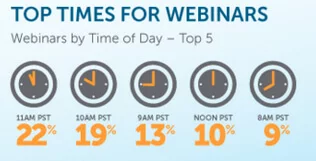
Research has shown that webinars held on Mondays and Fridays are less visited than those held on other days of the week. Other polls state that attendance is low on Tuesdays.
Optimize Your Webinar Timing for Maximum Attendance
Summarize with
Structure
What is the best time for a webinar?
At MyOwnConference, we believe that people can attend your webinar even on a Friday night if they see it’s worth it. So, having studied the research, we arrived at our own conclusions.
Pick the best day
According to a survey by ON24, 28% of users are ready to attend a webinar on Monday or Thursday. Friday gets only 7% of people that are ready to visit a webinar in view of the coming weekend. The weekend itself demonstrates even worse results at 2% of the people surveyed. Well, that is no surprise. People generally want to relax and unwind over the weekend, often with mindless entertainment, not with an intense information session such as a webinar.
Webinar attendance also varies depending on the time of the day. When held during lunchtime and after 7 p.m. the same broadcast will gather a different number of guests. According to ON24, the optimum time is 11:00 a.m. — it was preferred by 22% of users. If held at 8 a.m., the same webinar would gather twice as fewer people (9%). Clearly, most people aren’t early birds that want to jump on a webinar first thing in the morning. They need time to ease into the day before thinking of participating in the event.

Plan your webinar based on feedback
Researchers do not take into account the peculiarities of your audience as well as the webinar topic. For instance, management webinars are more likely to be viewed during work time, while photography might be more popular in the evening. So, the best way to learn the time that is optimum for your audience is to ask your subscribers for their preferences. Create a poll using Google forms or SurveyMonkey and send the link to it via email. Otherwise, enable the field with time slots on the webinar pre-registration page. This way, you can see which times most people selected and get an idea of which time is best to host your webinar and get the most listeners.
Picking the best time could also be possible by experimenting with holding the same webinar at different times and days of the week, followed by its statistical analysis. Sometimes, the best way to evaluate something is to conduct a test phase. During this period, anything goes, and making mistakes is part of the process. As long as you understand your audience better and their preferred times after conducting your experiment, it’s worth the effort.
Note the time zones
People worldwide attend webinars, regardless of whether they live in Hamburg, New York, Dubai or Bangkok. That is why you need to consider the time difference when planning your webinar.
In general, you can tie the online event to the organizer’s time zone. An exception to this is when your participants live in one time zone, while you are in another one. In this case, you have to be considerate of your audience. After all, they are the reason you are hosting this webinar in the first place. So prioritizing their comfort should be your main aim.
Synchronize time with attendees
Users can easily forget about the time difference. Be sure to help your participants understand the exact time the webinar will start in their time zone. A lot of people easily mix up time zone calculations, and it can get pretty confusing with all the different time zones across the world.
With the help of Google, the current time for any city can be seen. Put the word “time” into the search bar and add the city name. Above the search output, Google will show the current time for the city in question. You can include this time zone conversion in your email to your participants to ensure they don’t get the timing wrong.
In summary
Use the research results above or ask your subscribers to help you pick the perfect event date. Schedule the session when most people are available and you will notice a big jump in attendance. MyOwnConference makes it easy to organize a high quality session in just a few minutes webinar time.
FAQ
Based on research by ON24, Monday and Thursday tend to attract about 28% of respondents who are willing to attend webinars. In contrast, Friday shows a significantly lower rate (~7%), and weekend days drop further (~2%). But this is only a general trend and your specific audience might prefer different days, so it’s wise to survey them or run tests.
The study indicates that 11:00a.m. (local time) is one of the most preferred slots (~22%). When webinars are scheduled too early (for example, 8:00a.m.), attendance tends to drop significantly. Still, this is a guideline, not a rule then always check what your audience finds convenient (e.g. lunch breaks, evenings).
You have several effective methods: 1) Include a multiple-choice time-slot question in your registration or pre-registration form. 2) Send out a short poll (via Google Forms, SurveyMonkey, etc.) to your mailing list asking preferred time options. 3) Experiment by running the same webinar topic at different days/times over several sessions and compare attendance metrics.
It’s essential to consider the time zones of your participants. If your audience is spread across zones, don’t just rely on your own zone. Provide time conversions (e.g. “this is 3:00p.m. GMT, 10:00a.m. EST, 8:00p.m. IST”) in your invitations and reminders. Also, double-check that participants understand which time zone the event is anchored to.
If many respondents skip the time preference question, you can: 1) Make the time-slot field mandatory (if your registration tool allows). 2) Limit the number of time options to reduce decision fatigue. 3) Use your past webinar data and always analyze when past attendance was highest and base future scheduling on those insights. 4) Choose a compromise slot (e.g. late morning) that generally works well, and then iterate over time based on real attendance patterns.

Dedicated to enhancing your online meetings and webinars in today’s digital-first era. Join us as we share in-depth insights, proven strategies, and expert guidance on organizing, promoting, and excelling at virtual events and conferences.











